A Soft Computing Framework to Support Consumers in Obtaining Sustainable Appliances from the Market
Abstract
1. Introduction
2. Literature Review and Paper’s Contribution
2.1. Literature Review
2.2. Paper’s Contribution
- (1)
- Maximization of a consumer’s economic wellbeing (water and energy consumption savings, investment savings, etc.);
- (2)
- Maximization of a consumer’s social wellbeing through their preferences (e.g., design, quality perceived, noise, and number of functions, among others);
- (3)
- Maximizing the consumer’s environmental wellbeing (avoidance of CO2 emissions, water savings);
- (4)
- Providing a methodology that allows obtaining several alternative sustainable solutions, which allow tackling some contingencies that eventually may occur (e.g., an out-of-stock electrical appliance initially recommended by the method).
3. Material & Research Method
3.1. Problem Statement and Case Study
3.2. Dataset
3.3. Proposed Approach
3.4. Strengths, Weakness, and Limitations of the Work
3.5. The Optimization Method Non-Dominated Sorting Genetic Algorithm II (NSGAII)
4. Results and Discussion
- Selection method: tournament
- Crossover method: double point
- Mutation method: random mutation (one point)
5. Conclusions & Future Work
Author Contributions
Funding
Conflicts of Interest
Appendix A


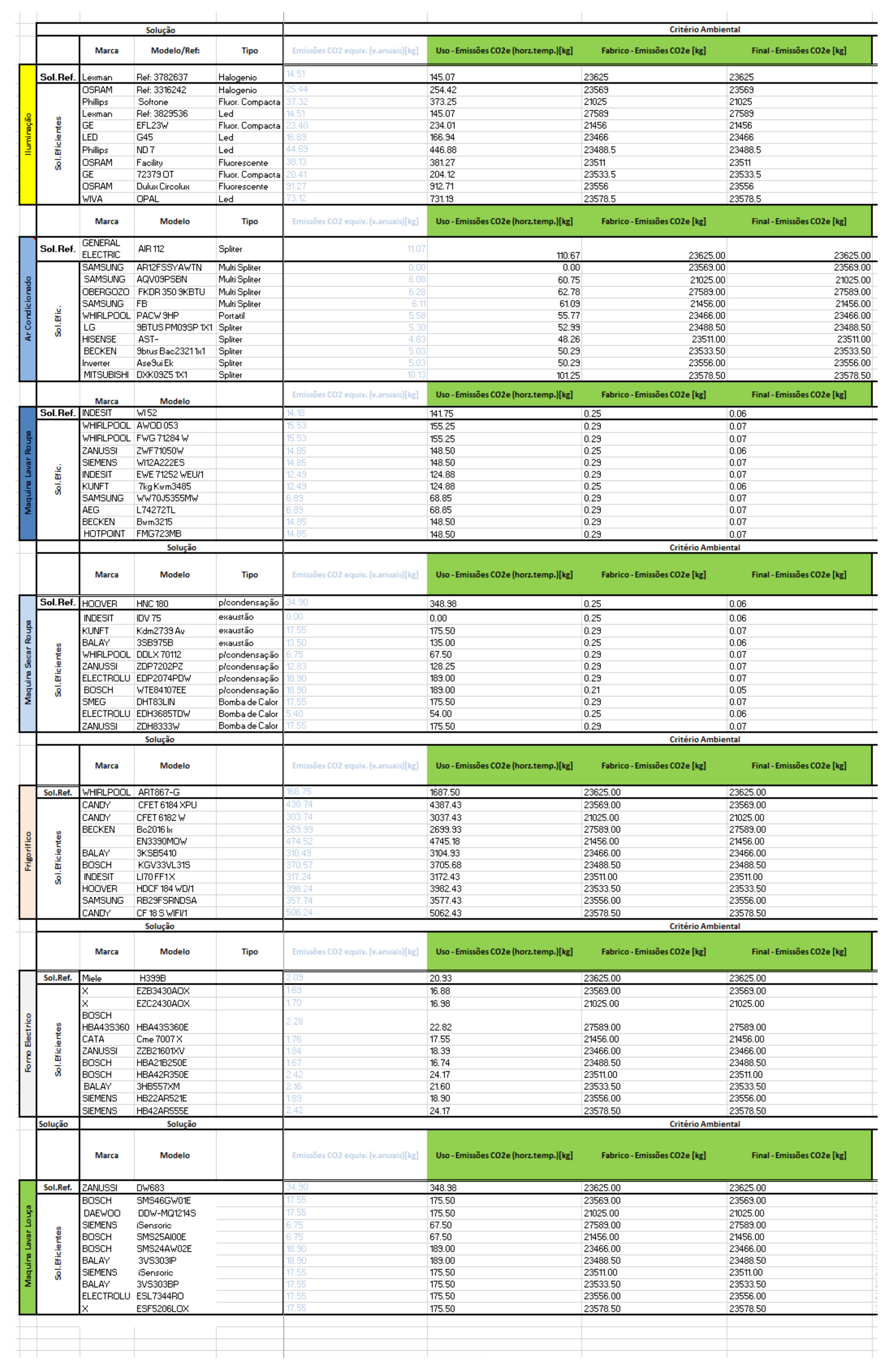
Appendix B
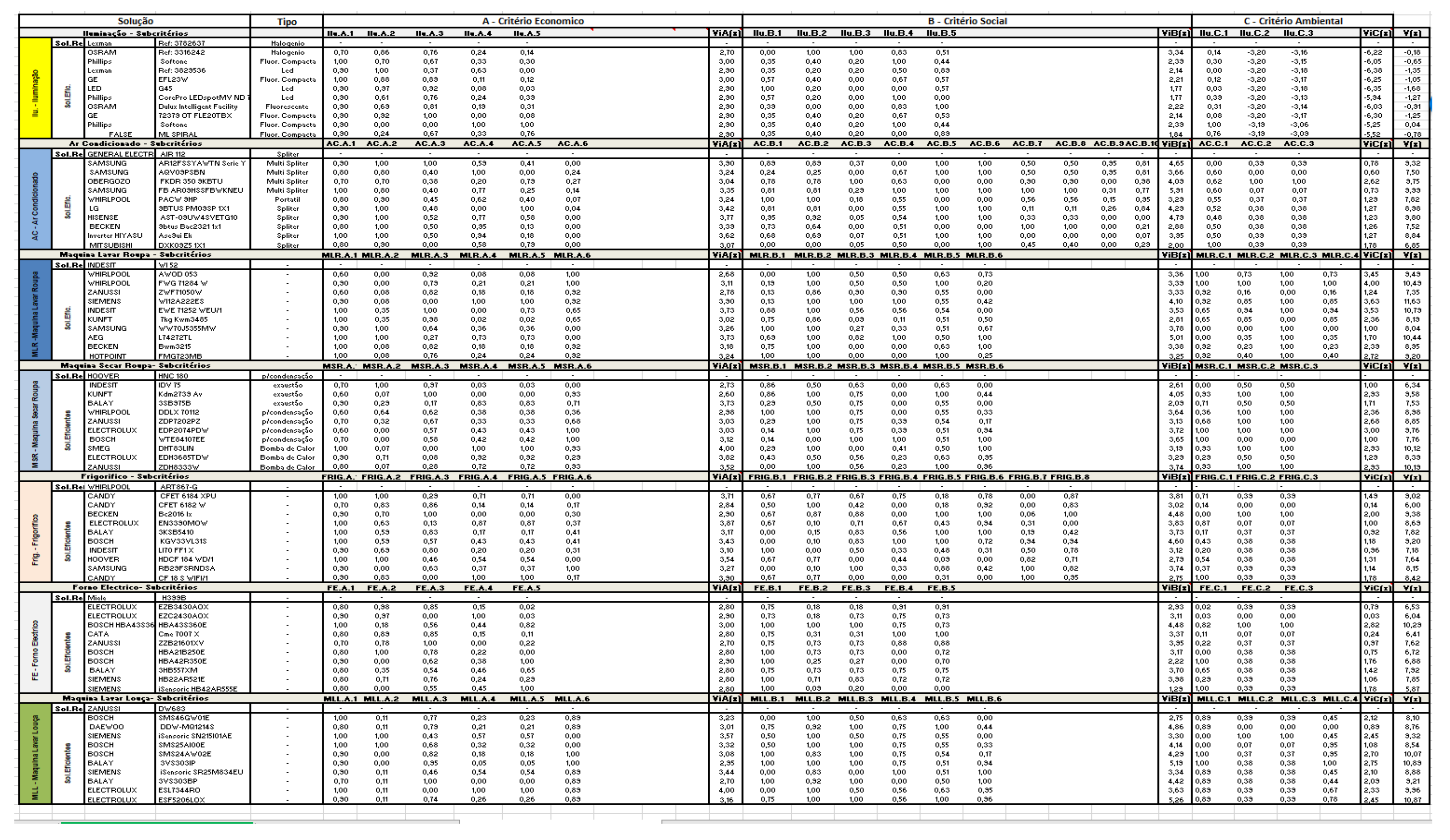
References
- IEA. Energy Efficiency 2019—Market Reports Series; OECD/IEA: Paris, France, 2019. [Google Scholar]
- IPCC. Climate Change 2014: Mitigation of Climate Change Summary for Policymakers and Technical Summar; Intergovernmental Panel on Climate Change (IPCC): Geneva, Switzerland, 2015; ISBN 978-92-9169-142-5. [Google Scholar]
- EC. 2020 Climate & Energy Package. Available online: https://ec.europa.eu/clima/policies/strategies/2020_en (accessed on 28 March 2019).
- Anastasiades, K.; Blom, J.; Buyle, M.; Audenaert, A. Translating the circular economy to bridge construction: Lessons learnt from a critical literature review. Renew. Sustain. Energy Rev. 2020, 117, 109522. [Google Scholar] [CrossRef]
- EU. Climate and Energy Framework. Available online: https://www.consilium.europa.eu/en/policies/climate-change/2030-climate-and-energy-framework/ (accessed on 18 March 2019).
- ADENE. Energy Labelling; ADENE: Lisbon, Portugal, 2017; ISBN 978-972-8646-36-3. [Google Scholar]
- DGEG. Eficiência Energética em Edifícios—Programa E4; Direção Geral de Energia e Geologia: Lisboa, Portugal, 2012. (In Portuguese) [Google Scholar]
- Wong, L.; Krüger, E. Comparing energy efficiency labelling systems in the EU and Brazil: Implications, challenges, barriers and opportunities. Energy Policy 2017, 109, 310–323. [Google Scholar] [CrossRef]
- Mc Alister, C.; Green, S.; Fayole, C. Discussion Paper: Eco-Design as Part of Circular Economy—Implications for Market Surveillance; ECOS: Brussels, Belgium, 2018. [Google Scholar]
- Corbett, J.; Wardle, K.; Chen, C. Toward a sustainable modern electricity grid: The effects of smart metering and program investments on demand-side management performance in the US electricity sector 2009-2012. IEEE Trans. Eng. Manag. 2018, 65, 252–263. [Google Scholar] [CrossRef]
- Zapelloni, G.; Rellán, A.G.; Pastora, M.; Bugallo, B. Sustainable production of marine equipment in a circular economy: deepening in material and energy flows, best available techniques and toxicological impacts. Sci. Total Environ. 2019, 687, 991–1010. [Google Scholar] [CrossRef]
- Schroeder, P.; Anggraeni, K.; Weber, U. The relevance of circular economy practices to the sustainable development goals. J. Ind. Ecol. 2019, 23, 77–95. [Google Scholar] [CrossRef]
- Hao, S.; Kuah, A.T.; Rudd, C.D.; Wong, K.H.; Lai, N.Y.G.; Mao, J.; Liu, X. A circular economy approach togreen energy: Wind turbine, waste, and material recovery. Sci. Total Environ. 2020, 702, 135054. [Google Scholar] [CrossRef]
- Tang, J.; Tong, M.; Sun, Y.; Du, J.; Liu, N. A spatio-temporal perspective of China’s industrial circular economy development. Sci. Total Environ. 2019, 706, 135754. [Google Scholar] [CrossRef]
- Fell, M. Energy services a conceptual review. Energy Res. Soc. Sci. 2017, 27, 129–140. [Google Scholar] [CrossRef]
- Hoxha, E.; Jusselme, T. On the necessity of improving the environmental impacts of furniture and appliances in net-zero energy buildings. Sci. Total Environ. 2017, 596–597, 405–416. [Google Scholar] [CrossRef]
- Ko, M.J.; Kim, Y.S.; Chung, M.H.; Jeon, H.C. Multi-objective design for a hybrid energy system using genetic algorithm. Energies 2015, 8, 2924–2949. [Google Scholar] [CrossRef]
- Pombo, O.; Allacker, K.; Rivela, B.; Neila, J. Sustainability assessment of energy saving measures: A multi-criteria approach for residential buildings retrofitting a case study of the Spanish housing stock. Energy Build. 2016, 116, 384–394. [Google Scholar] [CrossRef]
- Randall, M.; Rawlins, T.; Lewis, A.; Kipouros, T. Performance Comparison of Evolutionary Algorithms for Airfoil Design. Procedia Comput. Sci. 2015, 51, 2267–2276. [Google Scholar] [CrossRef]
- Santos, R.; Abreu, A.; Matias, J.C.O. Energy Efficiency in buildings by using evolutionary algorithms: An approach to provide efficiency choices to the consumer, considering the rebound effect. In Proceedings of the Technological Innovation for Resilient Systems: 9th IFIP WG 5.5/SOCOLNET Advanced Doctoral Conference on Computing, Electrical and Industrial Systems, DoCEIS 2018, Costa de Caparica, Portugal, 2–4 May 2018; Springer: Basel, Switzerland, 2018. ISBN 978-3-319-78574-5. [Google Scholar]
- Rubaiee, S.; Cinar, S.; Yildirim, M.B. An Energy-Aware Multiobjective Optimization Framework to Minimize Total Tardiness and Energy Cost on a Single-Machine Non preemptive Scheduling. IEEE Trans. Eng. Manag. 2018, 66, 699–714. [Google Scholar] [CrossRef]
- Jafari, A.; Valentin, V. An optimization framework for building energy retrofits decision-making. Build. Environ. 2017, 115, 118–129. [Google Scholar] [CrossRef]
- Chuah, J.W.; Raghunathan, A.; Jha, N.K. ROBESim: A retrofit oriented building energy simulator based on EnergyPlus. Energy Build. 2013, 66, 88–103. [Google Scholar] [CrossRef]
- Jain, A.S.; Saikia, P.; Rakshit, D. Thermal energy performance of an academic building with sustainable probing and optimization with evolutionary algorithm. Therm. Sci. Eng. Prog. 2020, 17, 100374. [Google Scholar] [CrossRef]
- Mauro, G.M.; Hamdy, M.; Vanoli, G.P.; Bianco, N.; Hensen, J.L.M. A new methodology for investigating the cost-optimality of energy retrofitting a building category. Energy Build. 2015, 107, 456–478. [Google Scholar] [CrossRef]
- Heo, Y.; Augenbroe, G.; Graziano, D.; Muehleisen, R.T.; Guzowski, L. Scalable methodology for large scale building energy improvement: Relevance of calibration in model-based retrofit analysis. Build. Environ. 2015, 87, 342–350. [Google Scholar] [CrossRef]
- Le, K.N.; Tam, V.W.; Tran, C.N.; Wang, J.; Goggins, B. Life-Cycle Greenhouse Gas Emission Analyses for Green Star’s Concrete Credits in Australia. IEEE Trans. Eng. Manag. 2019, 66, 286–298. [Google Scholar] [CrossRef]
- Santos, R.S.; Matias, J.C.O.; Abreu, A.; Reis, F. Evolutionary algorithms on reducing energy consumption in buildings: An approach to provide smart and efficiency choices, considering the rebound effect. Comput. Ind. Eng. 2018, 126, 729–755. [Google Scholar] [CrossRef]
- Santos, R.; Matias, J.C.O.; Abreu, A. A New Approach to Provide Sustainable Solutions for Residential Sector. IFIP Adv. Inf. Commun. Technol. 2019, 553, 329–342. [Google Scholar] [CrossRef]

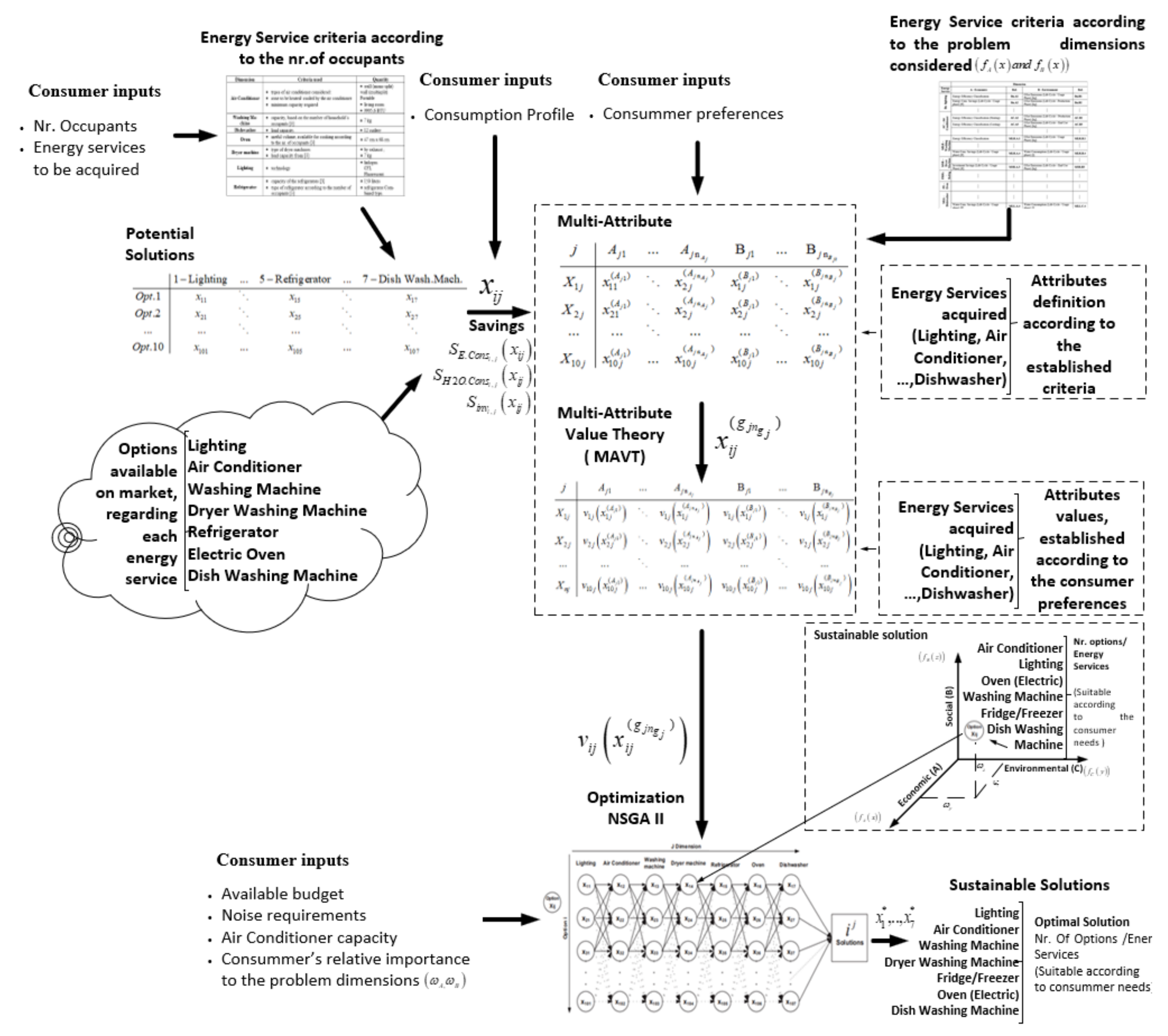
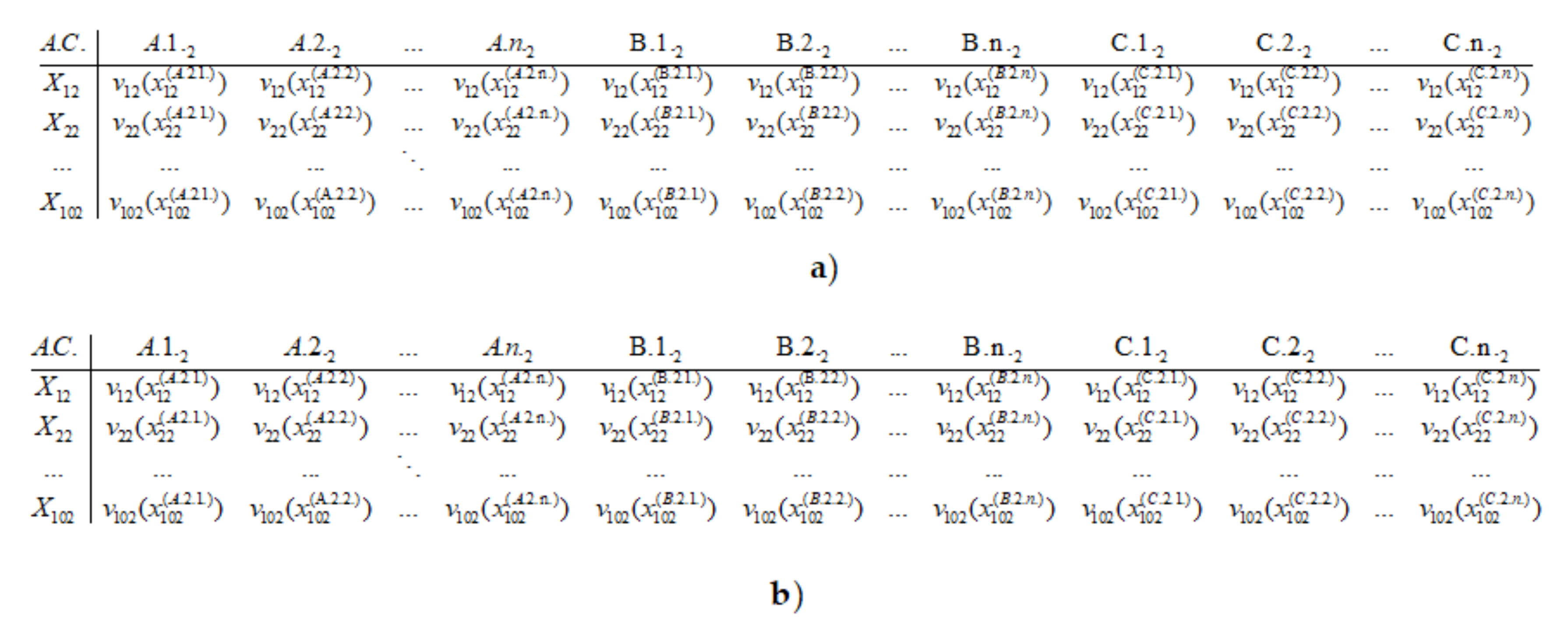
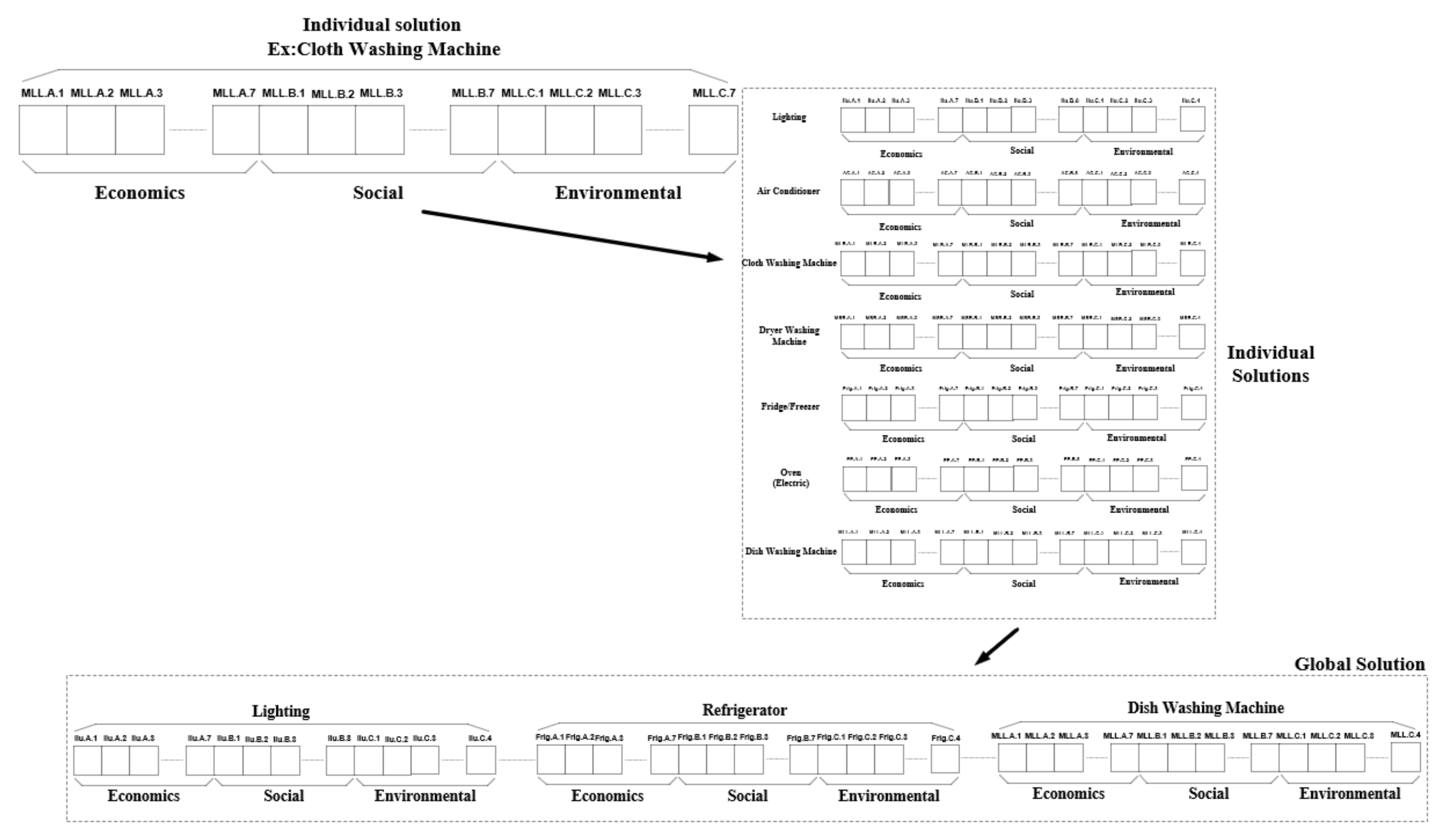
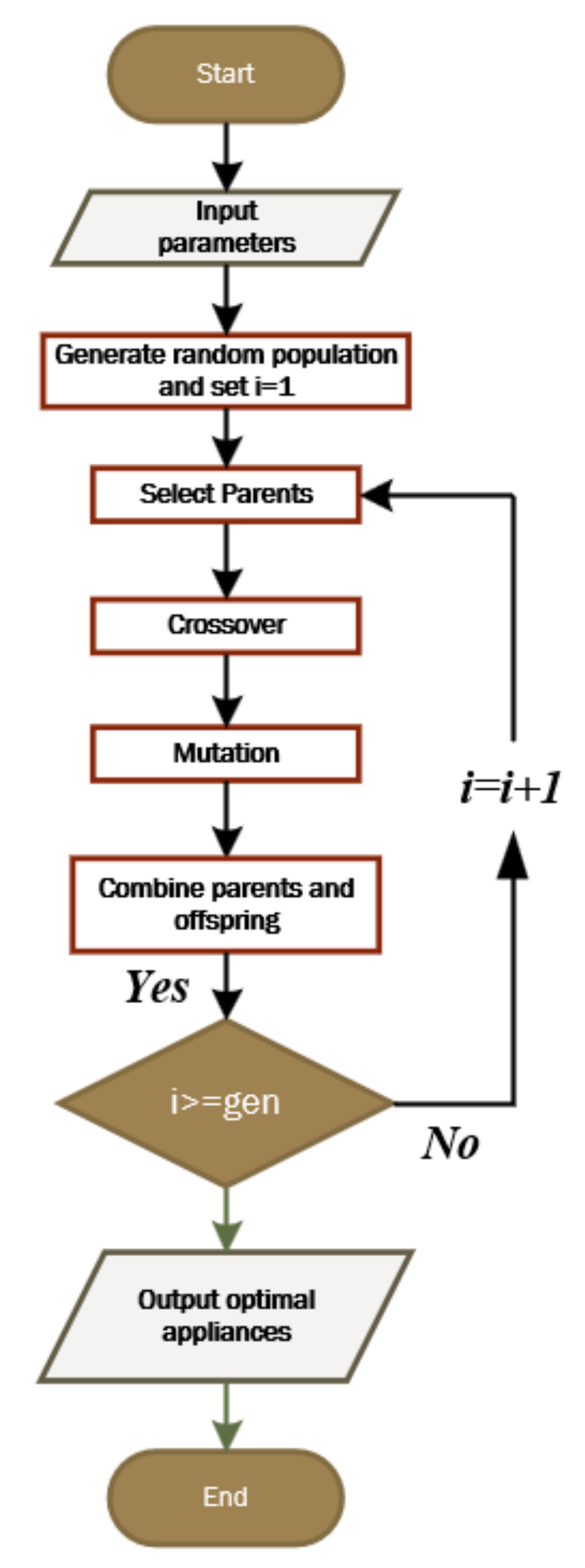
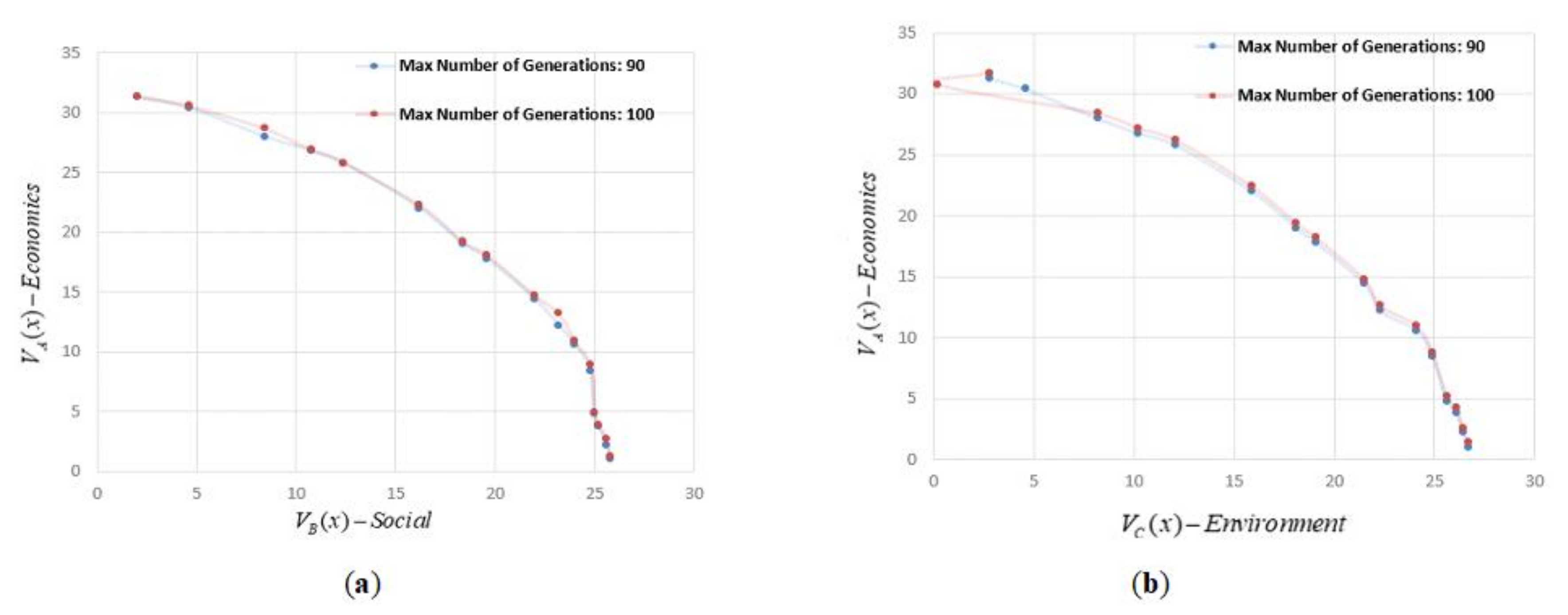
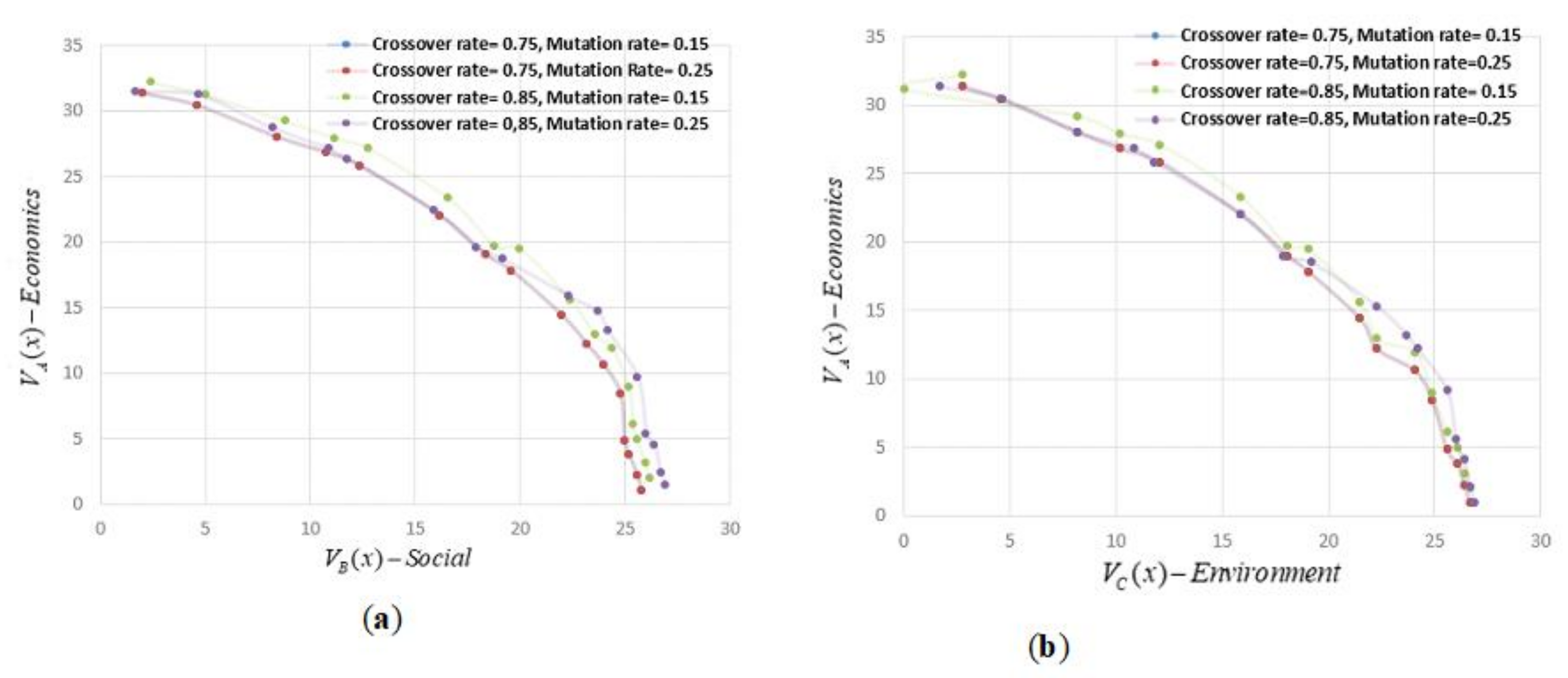

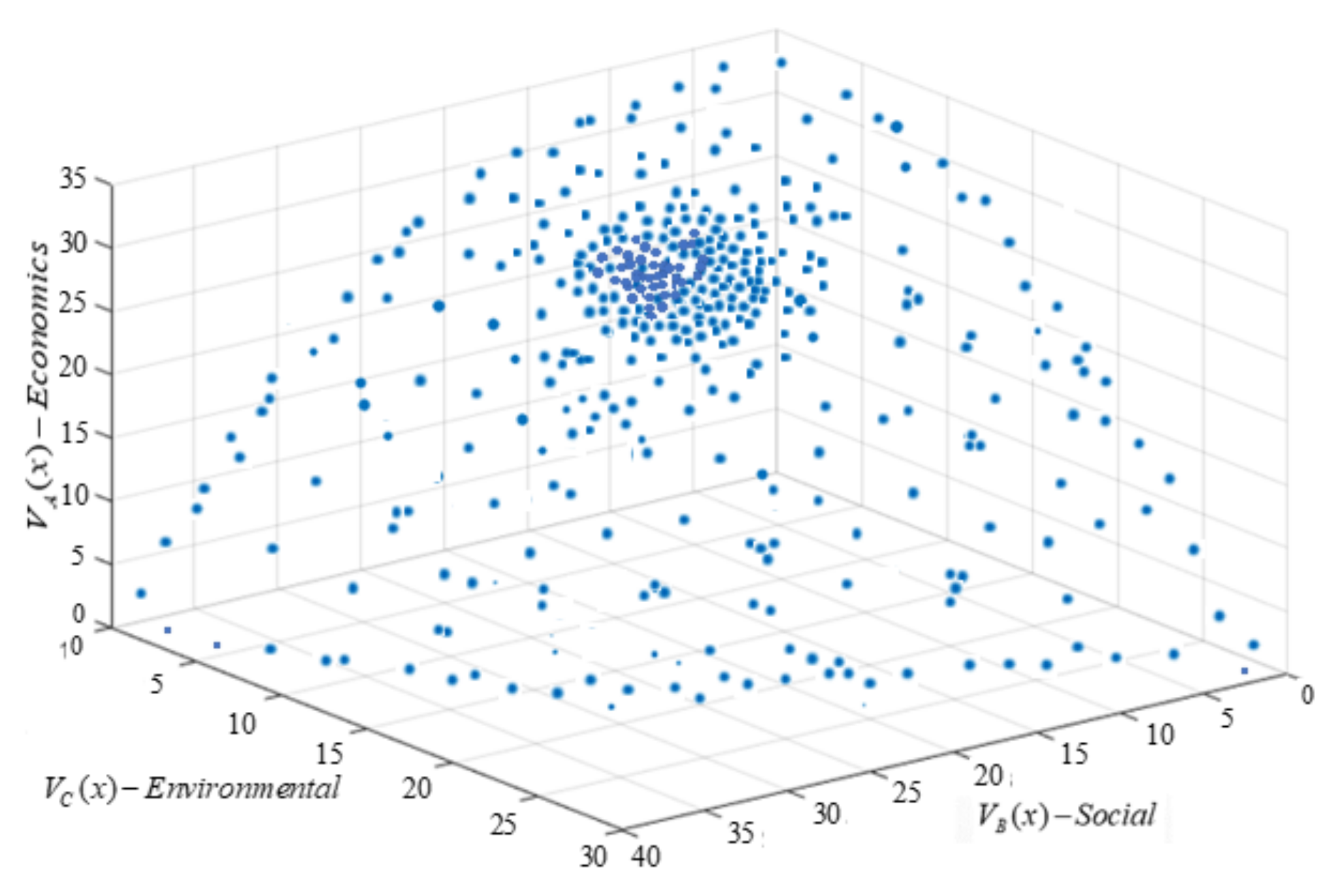
| Emission Factor (gCO2/kWh) | 675.00 | Discount Factor (%) | 7.00 |
|---|---|---|---|
| Lifecycle (usage phase) (years): | 10.00 | Annual Factor | 7.03 |
| Electrical Energy tariff () (€/kWh) | 0.16 | Water tariff () (€/m3) | 1.19 |
| Energy Service | Hours | |||
| Day | Week | Month | Year | |
| Dryer machine | 1.5 | 4.0 | 15.0 | 183.0 |
| Washing machine | 1.2 | 4.3 | 16.0 | 189.0 |
| Fridge/freezer | 11.0 | 76.3 | 329.1 | 4007.0 |
| Oven (electric) | 1.1 | 1.9 | 8.0 | 97.0 |
| Dishwasher machine | 1.0 | 4.1 | 16.0 | 193.0 |
| Air conditioning | 2.1 | 12.1 | 47.0 | 587.0 |
| Lighting | 5.0 | 35.2 | 150.1 | 1823.0 |
| Energy Service | Usage Frequency | |||
| Day | Week | Month | Year | |
| Dryer machine | 1 | 3 | 14 | 185 |
| Washing machine | 1 | 2 | 14 | 181 |
| Fridge/freezer | 1 | 6 | 28 | 359 |
| Oven (electric) | 1 | 2 | 7 | 94 |
| Dishwasher machine | 1 | 3 | 14 | 189 |
| Air conditioning | 1 | 4 | 22 | 276 |
| Lighting | 1 | 6 | 28 | 359 |
| Household Appliance Type | Dimension | Ref. | Dimension | Ref. | Dimension | Ref. |
|---|---|---|---|---|---|---|
| A—Economics | B—Social | C—Environment | ||||
| Ilu—light | Energy Efficiency Labeling | Ilu.A1 | Durability [h) | Ilu.B1 | CO2e (Avoided) emissions during the usage phase | Ilu.C1 |
| Percentage of recycling material [%) | Ilu.C2 | |||||
| Energy Cons. Savings (Lifecycle—Usage Phase) [€] | Ilu.A5 | Color Rendering Index (CRI) [%) | Ilu.B5 | CO2e (Avoided) emissions during the production phase | Ilu.C3 | |
| AC—Air Conditioning | Energy Efficiency Labeling (Heating) | AC.A1 | Noise (Indoor) [dB) | AC.B1 | CO2e (Avoided) emissions during the production phase | AC.C1 |
| Products can be repaired by other professionals | AC.C2 | |||||
| Energy Efficiency Labeling (Cooling) | AC.A6 | Customer Service (Warranty) | AC.B9 | CO2e (Avoided) emissions during the usage phase | AC.C3 | |
| FE—Oven (Electric) | Energy Efficiency Labeling | FE.A.1 | Design | FE.B1 | CO2e (Avoided) emissions during the usage phase | FE.C.1 |
| Accessibility (Product repaired by other people) | FEC2 | |||||
| Investment cost[€) | FE.A.5 | Perceived Satisfaction (by other clients) | FE.B.5 | CO2e (Avoided) emissions during the end use phase | FE.C.3 | |
| MLL—Dishwasher | Energy Efficiency Labeling | MLL.A.1 | Design | MLL.B.1 | CO2e (Avoided) emissions during the usage phase | MLL.C.1 |
| CO2e (Avoided) emissions during the end use phase | MLL.C2 | |||||
| Durability | MLL.C3 | |||||
| Water Cons. Savings (Lifecycle—Usage phase) [€) | MLL.A.6 | Perceived Satisfaction (by other clients) | MLL.B.6 | Water Consumption (Lifecycle—Usage phase) | MLL.C.4 |
| Trial | Crossover Value | Mutation Value |
|---|---|---|
| 1 | 0.75 | 0.15 |
| 2 | 0.75 | 0.25 |
| 3 | 0.85 | 0.15 |
| 4 | 0.85 | 0.25 |
| Electrical Household Appliance | Standard Solution Total Invest, (€) | Sust. sol. Total Invest (€) | Inv. Saving (€) | Energy Consump. Savings (€) | Water Consump. (avoided) (l) | CO2 Emissions (avoided) (kg) | Manuf. | Model Type |
|---|---|---|---|---|---|---|---|---|
| Light | 16.88 | 49.04 | 5.35 | 62.20 | - | 27.60 | Phillips | LEDspo |
| Air conditioning | 352.00 | 279.00 | 69.00 | 1319.50 | - | 1322.60 | Samsung | AQV09 |
| Refrigerator | 234.00 | 399.00 | −265.00 | 709.30 | - | 9.72 | Becken | Bc2016 I |
| Washing machine | 272.20 | 249,90 | −33,00 | 5.60 | 322.10 | 95.10 | INDESIT | EWE71 |
| Dishwasher machine | 310.00 | 349.00 | −39.00 | 3.20 | 423.00 | 6.90 | LG | DF212F |
| Oven | 171.00 | 701.00 | −28.30 | 2.82 | - | 2.33 | Electrolux | EZC243 |
| Clothes dryer | 368.00 | 449.00 | −68.00 | 10.20 | - | 1.82 | Bosch | WTE841 |
| Total | 1724.80 | 2475.94 | −262.65 | 2112.30 | 745.10 | 1458.90 | - | - |
© 2020 by the authors. Licensee MDPI, Basel, Switzerland. This article is an open access article distributed under the terms and conditions of the Creative Commons Attribution (CC BY) license (http://creativecommons.org/licenses/by/4.0/).
Share and Cite
Santos, R.; Abreu, A.; Soares, J.; Mendes, F.; Calado, J.M.F. A Soft Computing Framework to Support Consumers in Obtaining Sustainable Appliances from the Market. Appl. Sci. 2020, 10, 3206. https://doi.org/10.3390/app10093206
Santos R, Abreu A, Soares J, Mendes F, Calado JMF. A Soft Computing Framework to Support Consumers in Obtaining Sustainable Appliances from the Market. Applied Sciences. 2020; 10(9):3206. https://doi.org/10.3390/app10093206
Chicago/Turabian StyleSantos, Ricardo, António Abreu, José Soares, Fernanda Mendes, and João M.F. Calado. 2020. "A Soft Computing Framework to Support Consumers in Obtaining Sustainable Appliances from the Market" Applied Sciences 10, no. 9: 3206. https://doi.org/10.3390/app10093206
APA StyleSantos, R., Abreu, A., Soares, J., Mendes, F., & Calado, J. M. F. (2020). A Soft Computing Framework to Support Consumers in Obtaining Sustainable Appliances from the Market. Applied Sciences, 10(9), 3206. https://doi.org/10.3390/app10093206







